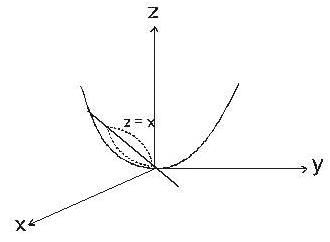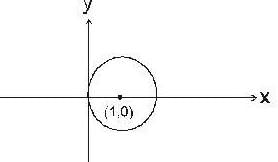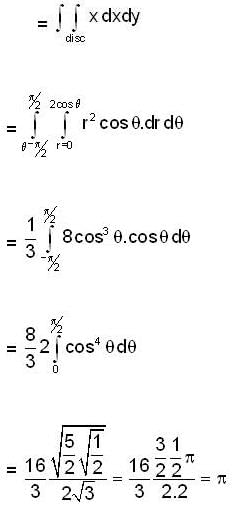Mathematics Exam > Mathematics Questions > The volume of the solid which is bounded by t...
Start Learning for Free
The volume of the solid which is bounded by the surfaces 2z = x2 +y2 and z = x is,
- a)π
- b)π/4
- c)π/2
- d)None
Correct answer is option 'A'. Can you explain this answer?
| FREE This question is part of | Download PDF Attempt this Test |
Verified Answer
The volume of the solid which is bounded by the surfaces 2z = x2 +y2 a...
curve of intersection








Most Upvoted Answer
The volume of the solid which is bounded by the surfaces 2z = x2 +y2 a...
To find the volume of the solid bounded by the surfaces 2z = x^2 + y^2 and z = x, we need to determine the limits of integration.
First, let's graph the surfaces to visualize the solid.
The surface 2z = x^2 + y^2 represents a paraboloid, while the surface z = x represents a plane.
By setting 2z = x^2 + y^2 equal to z = x, we can find the intersection points.
x^2 + y^2 = 2x
x^2 - 2x + y^2 = 0
(x - 1)^2 + y^2 = 1
This equation represents a circle centered at (1, 0) with a radius of 1.
To determine the limits of integration for x and y, we need to find the boundaries of the circle.
For x, the limits will be the x-values of the intersection points of the circle with the plane z = x.
(x - 1)^2 + y^2 = 1
(x - 1)^2 = 1 - y^2
x - 1 = ±√(1 - y^2)
x = 1 ± √(1 - y^2)
Since we want the volume of the solid bounded by the surfaces, we need to find the limits of integration for z as well.
From the equation z = x, we can see that z will vary from the minimum value of x to the maximum value of x.
The minimum value of x is 1 - √(1 - y^2) and the maximum value of x is 1 + √(1 - y^2).
Now, the volume V can be calculated using a triple integral:
V = ∫∫∫ dV
= ∫∫∫ dz dy dx
Since the region of integration is circular, we can use cylindrical coordinates.
V = ∫∫∫ r dz dy dx
The limits of integration for r, θ, and z will be as follows:
r: 0 to 1 (since we are integrating over a circle with radius 1)
θ: 0 to 2π (since we are integrating over the full circle)
z: x to x^2 + y^2
Now we can set up the triple integral:
V = ∫∫∫ r dz dy dx
= ∫[0 to 2π] ∫[0 to 1] ∫[x to x^2 + y^2] r dz dy dx
To evaluate this integral, we can integrate with respect to z first:
V = ∫[0 to 2π] ∫[0 to 1] [r(x^2 + y^2 - x)] dy dx
Next, we integrate with respect to y:
V = ∫[0 to 2π] [r(x^2y + (y^3/3) - xy)]|[0 to 1] dx
= ∫[0 to 2π] [r(x^2 + (1/3) - x)] dx
Finally, we integrate with respect to x:
V = [r(x^3/3 + (x/3) - (x^2/2))]|[0 to
First, let's graph the surfaces to visualize the solid.
The surface 2z = x^2 + y^2 represents a paraboloid, while the surface z = x represents a plane.
By setting 2z = x^2 + y^2 equal to z = x, we can find the intersection points.
x^2 + y^2 = 2x
x^2 - 2x + y^2 = 0
(x - 1)^2 + y^2 = 1
This equation represents a circle centered at (1, 0) with a radius of 1.
To determine the limits of integration for x and y, we need to find the boundaries of the circle.
For x, the limits will be the x-values of the intersection points of the circle with the plane z = x.
(x - 1)^2 + y^2 = 1
(x - 1)^2 = 1 - y^2
x - 1 = ±√(1 - y^2)
x = 1 ± √(1 - y^2)
Since we want the volume of the solid bounded by the surfaces, we need to find the limits of integration for z as well.
From the equation z = x, we can see that z will vary from the minimum value of x to the maximum value of x.
The minimum value of x is 1 - √(1 - y^2) and the maximum value of x is 1 + √(1 - y^2).
Now, the volume V can be calculated using a triple integral:
V = ∫∫∫ dV
= ∫∫∫ dz dy dx
Since the region of integration is circular, we can use cylindrical coordinates.
V = ∫∫∫ r dz dy dx
The limits of integration for r, θ, and z will be as follows:
r: 0 to 1 (since we are integrating over a circle with radius 1)
θ: 0 to 2π (since we are integrating over the full circle)
z: x to x^2 + y^2
Now we can set up the triple integral:
V = ∫∫∫ r dz dy dx
= ∫[0 to 2π] ∫[0 to 1] ∫[x to x^2 + y^2] r dz dy dx
To evaluate this integral, we can integrate with respect to z first:
V = ∫[0 to 2π] ∫[0 to 1] [r(x^2 + y^2 - x)] dy dx
Next, we integrate with respect to y:
V = ∫[0 to 2π] [r(x^2y + (y^3/3) - xy)]|[0 to 1] dx
= ∫[0 to 2π] [r(x^2 + (1/3) - x)] dx
Finally, we integrate with respect to x:
V = [r(x^3/3 + (x/3) - (x^2/2))]|[0 to

|
Explore Courses for Mathematics exam
|

|
Similar Mathematics Doubts
The volume of the solid which is bounded by the surfaces 2z = x2 +y2 and z = x is,a)πb)π/4c)π/2d)NoneCorrect answer is option 'A'. Can you explain this answer?
Question Description
The volume of the solid which is bounded by the surfaces 2z = x2 +y2 and z = x is,a)πb)π/4c)π/2d)NoneCorrect answer is option 'A'. Can you explain this answer? for Mathematics 2024 is part of Mathematics preparation. The Question and answers have been prepared according to the Mathematics exam syllabus. Information about The volume of the solid which is bounded by the surfaces 2z = x2 +y2 and z = x is,a)πb)π/4c)π/2d)NoneCorrect answer is option 'A'. Can you explain this answer? covers all topics & solutions for Mathematics 2024 Exam. Find important definitions, questions, meanings, examples, exercises and tests below for The volume of the solid which is bounded by the surfaces 2z = x2 +y2 and z = x is,a)πb)π/4c)π/2d)NoneCorrect answer is option 'A'. Can you explain this answer?.
The volume of the solid which is bounded by the surfaces 2z = x2 +y2 and z = x is,a)πb)π/4c)π/2d)NoneCorrect answer is option 'A'. Can you explain this answer? for Mathematics 2024 is part of Mathematics preparation. The Question and answers have been prepared according to the Mathematics exam syllabus. Information about The volume of the solid which is bounded by the surfaces 2z = x2 +y2 and z = x is,a)πb)π/4c)π/2d)NoneCorrect answer is option 'A'. Can you explain this answer? covers all topics & solutions for Mathematics 2024 Exam. Find important definitions, questions, meanings, examples, exercises and tests below for The volume of the solid which is bounded by the surfaces 2z = x2 +y2 and z = x is,a)πb)π/4c)π/2d)NoneCorrect answer is option 'A'. Can you explain this answer?.
Solutions for The volume of the solid which is bounded by the surfaces 2z = x2 +y2 and z = x is,a)πb)π/4c)π/2d)NoneCorrect answer is option 'A'. Can you explain this answer? in English & in Hindi are available as part of our courses for Mathematics.
Download more important topics, notes, lectures and mock test series for Mathematics Exam by signing up for free.
Here you can find the meaning of The volume of the solid which is bounded by the surfaces 2z = x2 +y2 and z = x is,a)πb)π/4c)π/2d)NoneCorrect answer is option 'A'. Can you explain this answer? defined & explained in the simplest way possible. Besides giving the explanation of
The volume of the solid which is bounded by the surfaces 2z = x2 +y2 and z = x is,a)πb)π/4c)π/2d)NoneCorrect answer is option 'A'. Can you explain this answer?, a detailed solution for The volume of the solid which is bounded by the surfaces 2z = x2 +y2 and z = x is,a)πb)π/4c)π/2d)NoneCorrect answer is option 'A'. Can you explain this answer? has been provided alongside types of The volume of the solid which is bounded by the surfaces 2z = x2 +y2 and z = x is,a)πb)π/4c)π/2d)NoneCorrect answer is option 'A'. Can you explain this answer? theory, EduRev gives you an
ample number of questions to practice The volume of the solid which is bounded by the surfaces 2z = x2 +y2 and z = x is,a)πb)π/4c)π/2d)NoneCorrect answer is option 'A'. Can you explain this answer? tests, examples and also practice Mathematics tests.

|
Explore Courses for Mathematics exam
|

|
Suggested Free Tests
Signup for Free!
Signup to see your scores go up within 7 days! Learn & Practice with 1000+ FREE Notes, Videos & Tests.


















